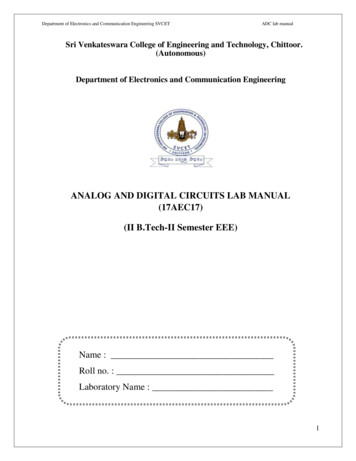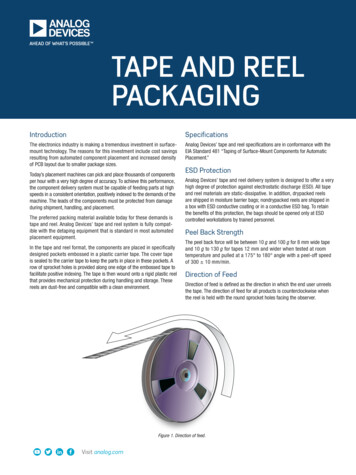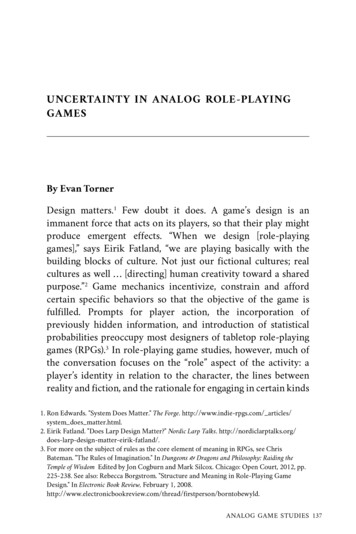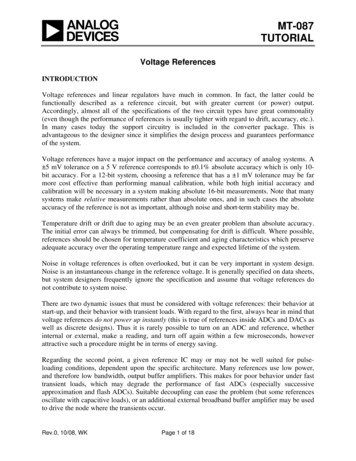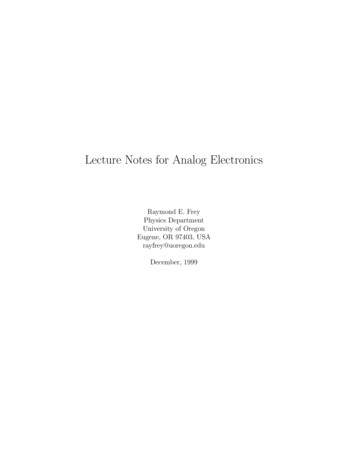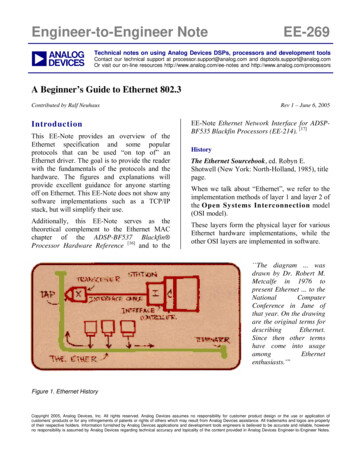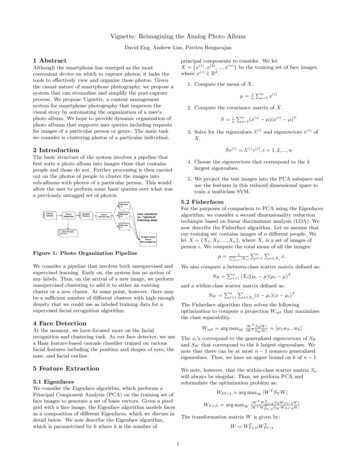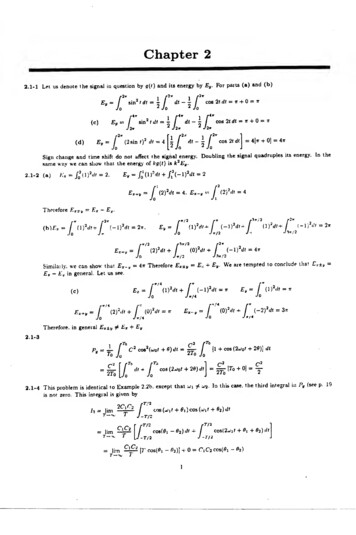
Transcription
Chapter22.1-1Let us denote the signalquestion by q(t) andin/ 2"Eg ——dttJ fEg(c)2sinsin2 f1(d) Sign change and time2 (a)/ ;,-2dt 4Eg2. j— l) J2 dt „2rr.(dtEz — Egin general./ *.„ thattr 0 4[5t tr dt 0]4iritsenergy.In the 3 *-*4.-(2} dt 4Let-dt )1)dt 2tr y-2.2 t/t(0)/(1Jj(-l) d(/ 47TJ%n/2Jir/24rr/ 2»(-ifdt 2 /t/-a»/2/ » Therefore **„E v We „ .tempted to conclude thatare ,. 1) us see.r*fw/A2 x (c)(1/) f 22./f(2JTherefore, in general E* j, (0) dtJ(-l)/2 c/«Ey7T 2 *-7T„fnI2)dt dt. 3tr(177*'0*/ ir/4,/o * „ 2rW22(2)JOwe can showitDoubling the signal quadruples y,»/2 z , Similarly,cos2tl"*/ 23(\) dt Eg.7rr2rr,.r(bl Eg(20k 1 Eg.is2J itcos 2t dt \J /*(- l) 2 dt (1 ) dt/J Therefore **„ - Ezdtaffect the signal energy. JJlKJthat the energy of kg(t) /*( 1 ?dido notshiftsame wav we can show02rdt-\ (1Ji w(2 sinyFor parts (a) and (b).cos 2t dt-JIdlf1-dt-Eyenergy by1J2»2.1-its (0Jdf( -)J2/ Ez «2.1-3. — oC2/2cos (wotdl 4./2 0 [Joisisidentical tonot zero. This integral is .cos (2w 0 ' 29)] dt/1cos (2-uo* 29) dt 2.2b. except that w,i-—r 2- To27 a* In 0] !2the third integral inthis case,r2C,r2limT—*x. 1given byTr-4 lim - f JoExample1-T/2rT/2T/ rrC1C2J /cos(9j —/Tf L[J-T/2-T/2 0)dt.rTach)z-»2 2.1-4 This problem J0limT — *x.—'I62) dt[7’cos(9i—rn/cos(2-vjt 0\J-r/i'—4-9j) 4710— 162 cos(9i —O2) 6j) dtPg(see p. 19
Thereforep9 - . Qi C1C2 cos(0i-#2)2.1-5-u;-{l'fdtffdt P(a)64/764/7222(b)P2y Ij(Ot'fdtSign change of a signal does notbv a factorc 4(64/7)affect its J(«) P«.256/7)dt a constantpower. Multiplication of a signal by64 c-2/incieases thepo2.2 1-6.(a)P,-ifJ* -tdt \ (1-a’ap’ t,b»f c-jyp.(d)-i/'Ps « mv) L( i)-t/t( ) 1rft52.1-7‘[i)g {t)d1P“ The7of sinusoids).These terms,T/2/T/,sinusoid of amplitude(., P„.«, of .JXtZ,this case(c) (10 P are periodic signalsare finite because the integrandsterms(.* r) yieldiningThe remad00. yield . * Twhen divided by J,hc "(C1 r,“.isC*/2to fh.2-nkmmk rr.IE,. (2-6.))sum«rik. ',For a real ar3o ‘dt .oorT/2ocFor imaginary e.leta—j*Thenr/2P„ IlifiT-I,(rjx')(r '} T/ ;2xt)dt lint—(at# E,. «.«S) . 178p lOcos 10/ sin 13/ - sin 3/. Hence from Eq. (2.6 ) 25 5 (cos 5/ cos lot. Hence from Eq. (2.6b) P4 «»2.2-1— iU fr«,u«ncvofof tit* powet, o, .h.2 sin 3f) cos 10/(d) 10 cos 5/cos lOtdirfJ-r,*i?JkS. T ntermsintegrals of the cross-product(made upDkD '/r7 2/t- t J-t/2dt 1 ph«.andThefts,inUi 51.5- d/O«./« - «/
Fig. S2.3-2Clearly,powerifisneither energy not power signal, However,ifaisimaginary,it isa power signal with1.g 3 {i)Ther “o is real. -. ?('1) .9t( tcan he obtained bysignalby h factor 2 (replacewith t/2).t9s(0!) (i)(iii) 9( -1) J'f f,-9*{f)-a(t 1 delaying ,U) by 1 « «lthen multiply with 1 o. Thus g s {t)2.3-2 All the signals are shownin2.3-3 All the signals are shownin Fig. S2.3-3 O.o)ffi(f.0.5)*- 1 » " -'l-OffljFig S2.3-2.*wFig. 52.3-32J' 42.4- ( .« - r.-/ -»’* ** 2.4- led - Til’d/tot- - »]’d.!-J- i Eoe(t) 1Using the(.)„fact that g(r)f‘(r)(hlPM »(*)dr .,V) d.eimpute * 2 In these problems remember ,ba.and so on.(a)The impulseislocated at r l-J «'/ ))’ d.8 V)* 0"- «’(') dl- as,E*we havei.)A«- 3 W-p('-l)(.)).(/) »V)d* F' J - w«' ]’di - ;**,- -[ag(J)ftl*Jg(0)h[r).E.I.,1and g(r)I.located a, aat r Ms3.0.(f)ge{w) (use L‘ Hbptlals rule)Thus, an impute.gU). Therefore* —) » '»»'“*a.rI.
(b)The impulse *(t)is at r0 and q(1- we obtain.r. (for n i 0,we show2.5-Thereforeis s(t)-t) dr ff(t)(h) -e dtthat this integralf-0)- (0). Thereforeis—0(t)t (at)dt.j2.5-0g(t)0)fSimilarly for r)»/r-fi[r)g(tUsing similar arguments, we obtains(g)p(-l)(f) 5(e) r(d) 0(c) 1nf r) at rL2.4-3 Letting-q(r)f (tL d(0) jjjj t (t)6(t)d1JTherefore» * »1TrivialTake the derivativeE x JQ'2 (a) In this caselitof e;1.3with respect toThe error(fisJand equate2g (t)dt2-tdt-t-si'M'M' \j(b) Thus, git, * 0.5.r«). and the error c«)and , tt he energy of the error) are- 0.5)r.itto zero.and jrE9 - w‘" J-0.5 over (0and1/3J0 Eti td, 1).0 band zero outs.de—J0.5)2rff this intervalAlso E„1/12orthogonal to r(t) because(tJ—05)(l) /f 0concepts we observe from Fig. 2.15explain these result, in terms of vectororthogonally, the length-square ofthiscomponent «. Because ofihat the error vector e is orthogonal to thee [sum of the energ.es of «r(f) andandcxoflengthso (O) equal to the sum of the square of theNote that #.To2g (l)dt f0r* x Xe f(0l- J02.5-3 In this case Eg‘2dttinterval*1.5,(/).and the errorr(l)Ez j sin 7 2ntdt — (b ) Thus.»(,)interval. Also--(l/*).r((). a andf r(t)g{t)dt 3 Jof0.5,Jtdt llJo Also , (the energy of the error).5-4 (a) In this caseand1/3. 4 EycThus. r(t)-r(t)is-1.5»(f) e /0(1- 11-5 1)- 1-Wdtover (0 t . D-1).and zero outsidethis»d -».« 1/4.and«(()»(')*and (h. .no,.(.)- dj jf , (the energy of the error) are4(sin 2irt l( ( / )»»to.— -1/-o«r(0
Eg Theerror\t f,g (t)dt (1 /tt) sin 2itl\ isjf’ t*Jt - ** a , [f- (l/*)sin f'22trf.](ftorthogonal to x (/.J becauseTO —sin 2trf[ JNote tho. e.and1/3-pH. L.(l/tr)sin 2irt]dt 0 iny,Because of this orthogonthe error vector e is orthogonal toe [sum of the energiesandexoflengthstheofsquaretheofsumtheequal to2.5-5 (a)the componentu(t) are orthogonal, thenandIf r(f)ex.of x(t)we can show the energy y(t)isofEx *«(t) and, ,y,EvrnvP1\x(t) y(t)\ dt p\r(t)\3dt dt 5 Thelastr(,)y‘(t)J2dt jJ\t)v(t)dt jj t)y{t)dt «( )t*dftwo integrals fthat because of orthogonality thex(t) y(t) is equal to that of x(t)ofenergytheThusr'(t)y(t) are zero [see Eq. (2.40)}.resultandJ .r(f) p\y(t)\followsfrom the(1(2))1fact,equal to that of ''i*(f)that the energy of c,r(t) n,,(t) is(b) Using similar argument, we can showEgivenby * m This energy is.r(/) and /(/) are orthogonal.that r(t) y(t). then it follows from Eq. (1) in the above derivation(c) IfM“V (t)ifify:(()E, Ex E v (Exy Eyx)and «a(3,0). From2.5-6 g,(2. -1). g a (-1.2). g.t(0. -2). *4(1.2). gs(2.1),this also analytically.verifyWecanorthogonal.aieg4 ) and (gj.gs)( glFig. S2.5-6.we.gvg« (0x3) (-2x0) 0g4gig 3 gsWe (2xi) (-lx2) 0 (-l x 2) (2x1) 0are also orthogonal.can show that the corresponding signal pairsP„i (t)q*(tult g 2 lt) gi (i) dt PPJ-'V-{-rMZx,[t)\di Q 2r,(f)- ra(0][*i(0 (t))dt 0 2x a (/)][2r,(f) x 3 (t)\dt 0sec that pairs (gs-ge).
we used theIn deriving these results, f xfrtjdt -fact that2 6-1.Wecomputeshall,In thesame way we1(3)’visxos)Ins)v/to.sHO.s)’Here To tit 2the signals.all0.50.5.for four cases are10 2irt dtenergies of0(2)/(sinfound as —2*/)(-sin 2vt)dtJ00.707 sinv.iviuuIfJJo0andr{t)Signals r(f)2.8-12trt sin 4trtsin 2f,v/tosinj Em Ets Egt findUsing Eq. (2.48). the correlation coefficients(1)'1compute theLet us first„ using Eq. (2.48) for each of the 4 cases.Ex T,(t)x s (t.) dtand12. 0mum -»2nt it32 (f) provide theso thato tr. 0.707 sin 2»r tdt-j 0. 707 sin 2irtdt/J 0.5[7 0protection against noise./ r:V 0!S) ( maximum 2tr/2J—(4)v»/1.414/ttIS)andVg(t) *o cosnirf -b n sinnrt.1 tIn lwhore-i /:noUsinmrfdt 0Therefore41Figure S2.8-1 shows q\l)The powerof q(l)—-cos turf1 f 11n 1for allt(-1)"n-32A'Iand the corresponding Fourierseries representing q(to\erisMoreover, from Farseval s theorem [Eq. (2.90)jPg— C0 /9" 3 )(b)Ifthe ;V- term Fourier seriesis2—2,ln«l Vdenoted byr(t),V— 114(rr*n 2)79isrequired 10 be99% P9 p.— l) n0.198. Therefore i 94 ”4- 9" 1thenn lThe power Pzitiri L*w4n*60.19811 1905I.1)
For ttThus,2.8-2 Here P,1. 3.T0 2rr.0.1111; for .V Px 2.N For0.19323. Px3.0.19837, whichisgreater than 0.198.Vso that u 0 2ff/2rr g (r)a01.andcosnt -sinntfe„ tt ttrwhereoo—2* f tdt — 0J-ra„, f2 * J-rt—cos nt dthn0, r2,,,J tsinr tdt .—2 (-irTherefore.»(*) 2(-l)" 1— -BinT)tir t irn*lFigure S2.8-2 shows g(t) tforallseries to represent g(t) over (-it,and the corresponding Fourierttr).1*1 iLoil]t-*Fig. S2.8-2The powerof j(t'jiss )’* -TMoreover, fioni Parsevalstheorem[Eq. (2.90)]1(b)Ifthe .Y-tetm Fourier seriesisdenoted byr(t).tr‘thens.T(t) 2(-l)” 1 isinn W- n t nnxlThe powerPxisrequired to be 0.90 xt 0.37T2.Therefore*-* *-"*Px » 2; for A’ 2. Pz 2.5.2Thus.2.9825. which is greater than 0.3 jtFor.V 1.forN N P,5, 2.927.whichislessthan 0.3 tt2.ForN-6.Px-62.8-3 Recall that[To/2flO;/J -To,'2(la).9(0*[To/ig(t) cos njjot dt1(lb)J -T0 /[To 12g(l) sin1J-To/2/dt(lc)
Wjs an oddWeven function and sinRecall also that cos n-»l is anfunction and fl (t)sinevenanalsoist. then g(i) cosWT /22nof:-t.J.»an odd JunctionMM,m(2a )(2 b)Tonr4q(t ) cos n*iQtAt1 ""johr,Similarly,iffunction ofan odd function ofTherefore*(*)t.t.isao (then g(t) cos nwo t bn 2 c)0andtg(t) sinr, tisan even(3a) «»an odd function ofis0M f '\mnn. Ut0retired to compute theObserve that because of symmetry, the intentioncoefficientsneed be performed over,only half the period.2.8-4 (a) To 4. -vo fBecause of even symmetry,-allsine terms are zero.*X,. ?(*) «o Y* a "cos\Tlnss 1n0 0 (by inspection)«--cosJ [/*Therefoie. the Fouriei series for q{t)(f')d1cos- (tOHereK(b) To3trt1at14 / - (cosy - gCOS— -cos-y1rnrcos7*t\2j7shows the plotFigure S2.8-4a 0. and we allow C„ to take negative values.all the sine termssymmetry,evenof lOtr. 3 Becauseof C„.are zero.qii) 00 «„ cos (Jf)».n0 «.-5nHere b„ shows the-k plot of2tt10 * -.(? )f sin f -tlV5 )J „and we allow C„0.(t') ftt.sin 1(bv inspection)-.(c) Tqs,nis5trfq(t) T'"]*dt & (H)(integrand0to take negative values.L A“!(? )Note thatisn ("«'an odd function ofCn a„forn t)0, 1, 2. 3,Cn-wo —1*9 (t) oo OnCosnt b„sinntwithno 0.5(by inspection)narl—,cosn "" 0'-,n -X 1sinS1ntdtITT)andq(t) 0.5- 0.5 i(sinf [cos ('sin 2/ -sm3f ) \cos (2/8sin4M4 §) )jcos (3* 0) ']Figure S2.8-4b
Figure S2.8-4d shows the plot of C„ and(e) To 3. uJo 23/'2 3i -/6. - o27rn, [cOS2nn,2nir(sin33 J03 03, d, .,2nn2nn.smcosC2nn2v— n.2andgc-- 532a 2 [V\/!(f) To3tJ ' 2J0 — — -T— 27 ' —--T —T2mriCOS:finTherefore Cofi„.2ir/3.rr/ 3—n— - 2c “— t 2cos4ir 24tr.110”2 —"2jtti2rrn4jtt 3andfinEven symmetry;0.5 (by inspection). 6n tan",2sh cos fco(Vcos 2iii ssin2 nin -1\)0.1r4«nnrr.,/ifij. 2 stit 361*60 522n/ 2(nrrlSirC0S2jrcos 3'-(2Jcos Zj-ttit2r)7r" rj— t5ir1cos,r '* 9t) cos20]fcos7t—\f JObserve that even harmonics vanish The reason is that if the dc (0.5) is subtracted fromfunction has half-wave symmetry. (See Prob. 2 8-6). Figure S2.8-4f shows the plot of C n 7(f).the resulting.2.8-5even function q r n) and an odd function 9 o (0 have the property thatAn— 9e( 0Se(()F.vety signal /(t)sumcan be expressed as a9(0 andCo(t) -flo (—0!1'and odd components because 2 i.9(0 - 9(-0]of even\ i.o(0#v«»ncan be seen that the first component on the right-hand side is an evenreplacing t by —1 in thefunction, while the second component is odd. This is readily seen from the fact thatyields the negative theyieldscomponentfirstFrom thethatTodefinitions in Eq. (1).itcomponent.find theodd and the even components9(0where {from Eq.— u(t).of g{t)-9«(0we have 9o(0(1)] iA ) 5M 0 «(-/)] and9 o(0 3MO - «(- 0 ! sgn(f)S2.8-5a.The even and odd components of the signal v(l) are shown in Fig.atn(t), we haveSimilarly, to find the odd and the even components of g(t) e. 9(0 where9,(0 i[e9» (0— 9o(0«(fJand10 e«u(-‘)]
ftOFig. S2.8-JSThe even and odd componentsFor g(f) r''.of the signaltttc shownu(t) arein Fig.S28-5b.we havee jl j«(f)flo(0where««(') 'K 3rJ *cos*jsin']andSoft)«[e jt- "'*]t2.8-6 (a) For half wave symmetry 7(0- 7 (t y)andi*To -1 [Toandg(t)cosn otdt—JO / 0Let r /- 7o/2in/*To7*0/3g(t)cosn« otdt/»(f)co«W«ft 'To/2./othe second integral. This givesr /2jfS (0 cos two* dt Jcosn ot dt4-Jg (* ycos nu'o (t)a- JL'g(f)] J,i.fTor\fl(f)cosnwoftitL/oIn a similarway we can show.thatl,(b)(i)Jo 8.-o j. no — 7(t)[- cosnwor) cfajr —To4fjTo/2g(t) sin nuiot ltJoHence0 (by inspection). Half wave symmetry.11 y) i*j
4ntr/ ( cos/r)7T43 it 3T17T.ntr., —SinIr rift\T T sm T 1,(n odd)12V 2(nod)) /Thereforeflu“,- t( 0 n 1n 3 7 11 , 155 9 13 .,.,,Similarlyfe" 12f Lsm LtL 11 n 2 tr 2 l42Hi coslil « -J-sinf )2 2TSm2n2 /V 2 /trand—nirH .9(0a„ cos„* —n7r ,on sin,f4n*l.S.5.-(ii)To 2ir.wo 1noHence0 (by inspection). Half wave symmetry n„ cosnf s0 (f)nn,, —rJ [j n 2tr l t,i0 ,1 S .cos nt(-0ilt1cosnf (nnsinnf)odd)0.011(01) n30.01o-*/10 001)107r{n'Jtil,,- tr/tOn2sin(- 0.1 )0.01-D 0.0465n2 0.01ande-,/l0sin nf /f* Jo- t/JO-(— 0.1 sinnfir n22n“2.9- 1(a):To 4.wo tr/2.Also(b) To 10*. wog (,) Do 5J- 1/52tr/10frD„r J S\:(e(n 2 —(nn cosnt)0.01odd)Jo-w/10-1 ) 0.01)1.461nn2 0,010 {by inspection)where D„ T tr- W, dt /12* H lint n ( 2jS '"t) "1"
-91-JUpIFig. S2.9-1(c /(i) Do '"r 2 D ”t-Where, by inspectionD0 andzDn 0.5r» -tiDn —rJ2ir(d) To ir.wo Q2and 2jt „ 0T -'2irnsothatl -l 2 r2*71{ll -i
(e)7'o 3. o.9(0—On 5 where rft 4 C3l*)\Therefore*lOnl-(f) To3,,.-22n4w /') -L2V:j4lr3n2 9 *73 Do 6. * 0/7T71and-2COS-3-iDn —tan-1 (2 ftn COS -5- 33cos1ir, 222" -t25asin\sinS1a2wn,3\1/0.5 *(t) 0.5 n*s-rtw,1Dn o1J/-a,1 ayHa1- l 1(-. 0C2*n \ J *»Cn nit(2K "J 5('“T- “ i TV-*t5U15t-31,'-‘* “mi i —-3J5*sn-Ml l"*nCS.-80-8.ti-t«ZCo)n4ajL 1- s1)3uO- a? 1.**i« Fig. S2.9-22.9-2q( 1 ) form,For a compact trigonometricreason,we rewrite3 costall sin 5t“" 2cos 8t(3)amplitudes must beterms must have cosine form andpositive.For this9(f) as9 (f) 3cosr cos(5t- - ) 2cos(8tas3 cos4-Icos 5t- 2 cos (b*--*)—)and phase spectra.Figure S2.9-2a shows amplitudespectra as shown“p: 09 q 2athe exponentialp2a, we plot intrigonometric spectra in Fig. S2.9(b) By inspection of thespectra in Fig. S2.9-2a, weS2.9-2b. By inspection of exponential,(„.y5,,. y-* * ['*-*’ i(I,-*)*-jSlr-« (.- »)14I.- (j''*) (''*)”in rig.
2.9-3 (a)g[t) 2 2cos(2 - n) 2-2 cos 2 1 (b)(c)The exponential spectra are shown inBy inspection of exponential spectrao(t) 2 cos(3t- )sin 3tFig. S2.9-3. [„ *- 2 2cos(2t -it) [e**'*’ r -r(«-f)] 5cos 3t-(trigonometric and exponential Fourier(d) Observe that the two expressionsseries) areequivalenFig. S2.9-32.9-4D„ -To/3rTo/2—f(t) cosriuiotdt.J-Ta /2If n't)isisr/(f) sin nu/of dlofbecause its integran
Fortt 1.P, 0.1111;for.V 2.Px 0.19323.ForN 3.Px 0.19837, whichisgreaterthan0.198. Thus,.V 3. 2.8-2HereT0 2rr.sothatu 0 2ff/2rr 1.and g(r) a0 cosnt fe„sinnt tt t .

